You found that Lightspeed isn’t fulfilling your eCommerce requirements anymore and want to switch to Shopify. Then, you have come to the right place. Our tutorial will shed light on everything you need to know about Lightspeed to Shopify migration.
Before we begin, let’s take a look at all the steps on how to migrate Lightspeed to Shopify with LitExtension – #1 Shopping Cart Migration Expert :
- Step 1: Run Lightspeed backups
- Step 2: Create your Shopify store
- Step 3: Set up Source and Target Cart
- Step 4: Select migration entities
- Step 5: Run Full Migration
- Step 6: Go through the post-migration checklist
Not gonna let you wait any longer; why don’t we get started?
Grow Beyond LightSpeed Restrictions on Shopify’s Pioneering Platform
Our team of experts can safely transfer your business data, products, customers, and orders to unlock more growth on Shopify’s robust platform. Let us streamline the migration seamlessly for you.
Switching from Lightspeed to Shopify – Preparation
1. Run Lightspeed backups
Backing up your data is an essential step before performing any major changes to your online store. By doing so, even if errors are happening during your migration, you can ensure that it does not affect your store’s performance.
LitExtension will not alter your Lightspeed Source Store database, so you can rest easy knowing that your data will be transferred without a hitch.
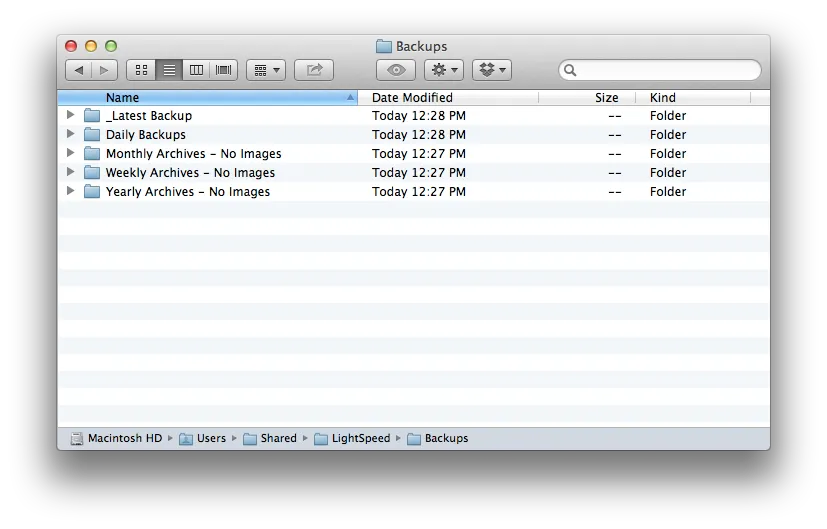
To run Lightspeed manual backup, you can easily perform the steps on the Onsite server as below:
- Go to Tools > Utilities > Backup Database from the OnSite Dashboard.
- Select “Backup” and wait for a few minutes.
- Your store data has been successfully backed up.
If you are using the Lightspeed eCommerce plan, then you can easily export data into a single folder for future reference. The steps are quite easy, too:
- Open the Tools > Exports page.
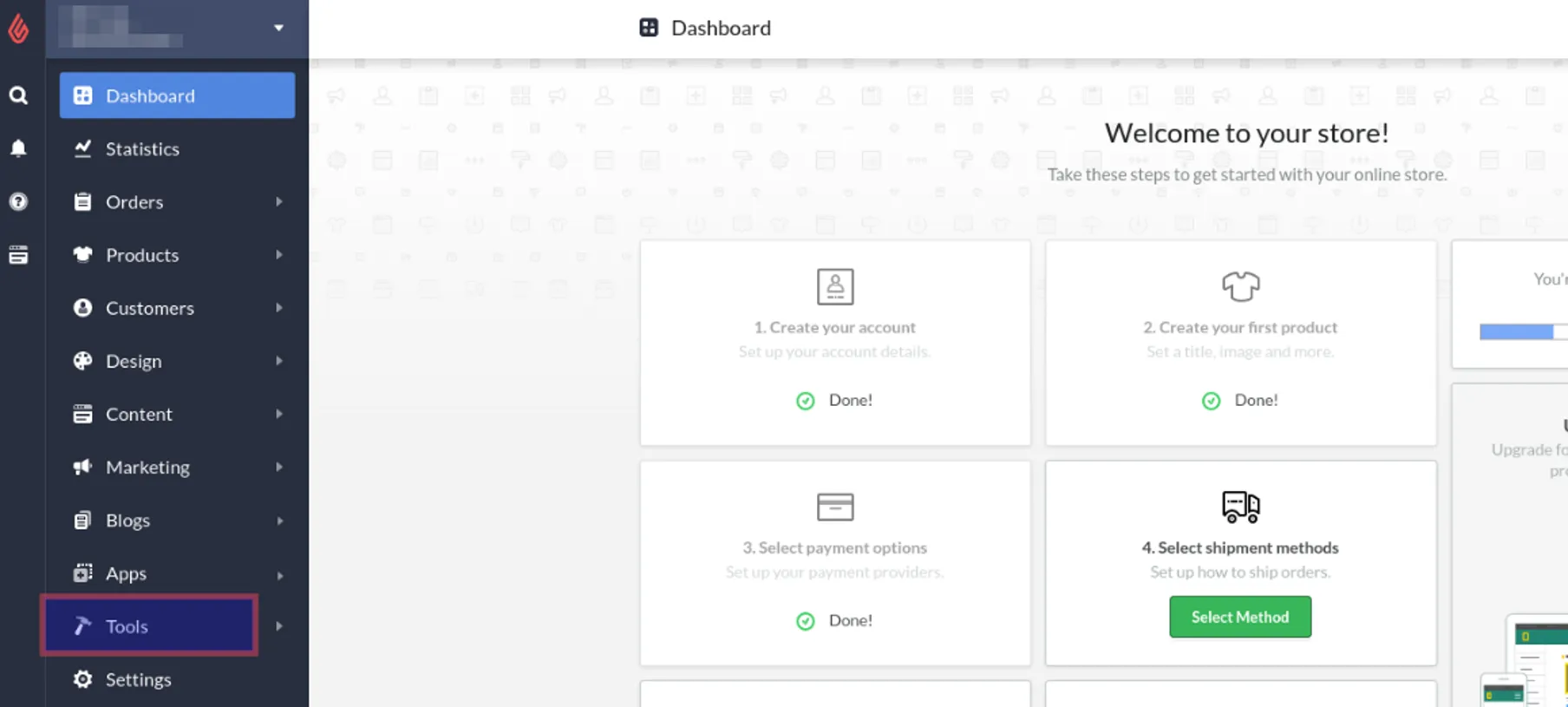
- Hit “New export”.
- Select types of data to export in the dropdown menu.
- Click on the “Export” button.
After finishing the backup steps, let’s move on to the next phase!
2. Create a Shopify store
Since you are moving to Shopify, you will need to set up your store on this platform beforehand. After the 3-day free trial, Shopify offers its new users the chance to extend their stay in the first three months for only $1/month. Seize the moment and start your eCommerce journey now!
First, navigate to their website and sign up for a new account. Then answers some questions to provide more information about your business, or you can hit “Skip All” to move on.
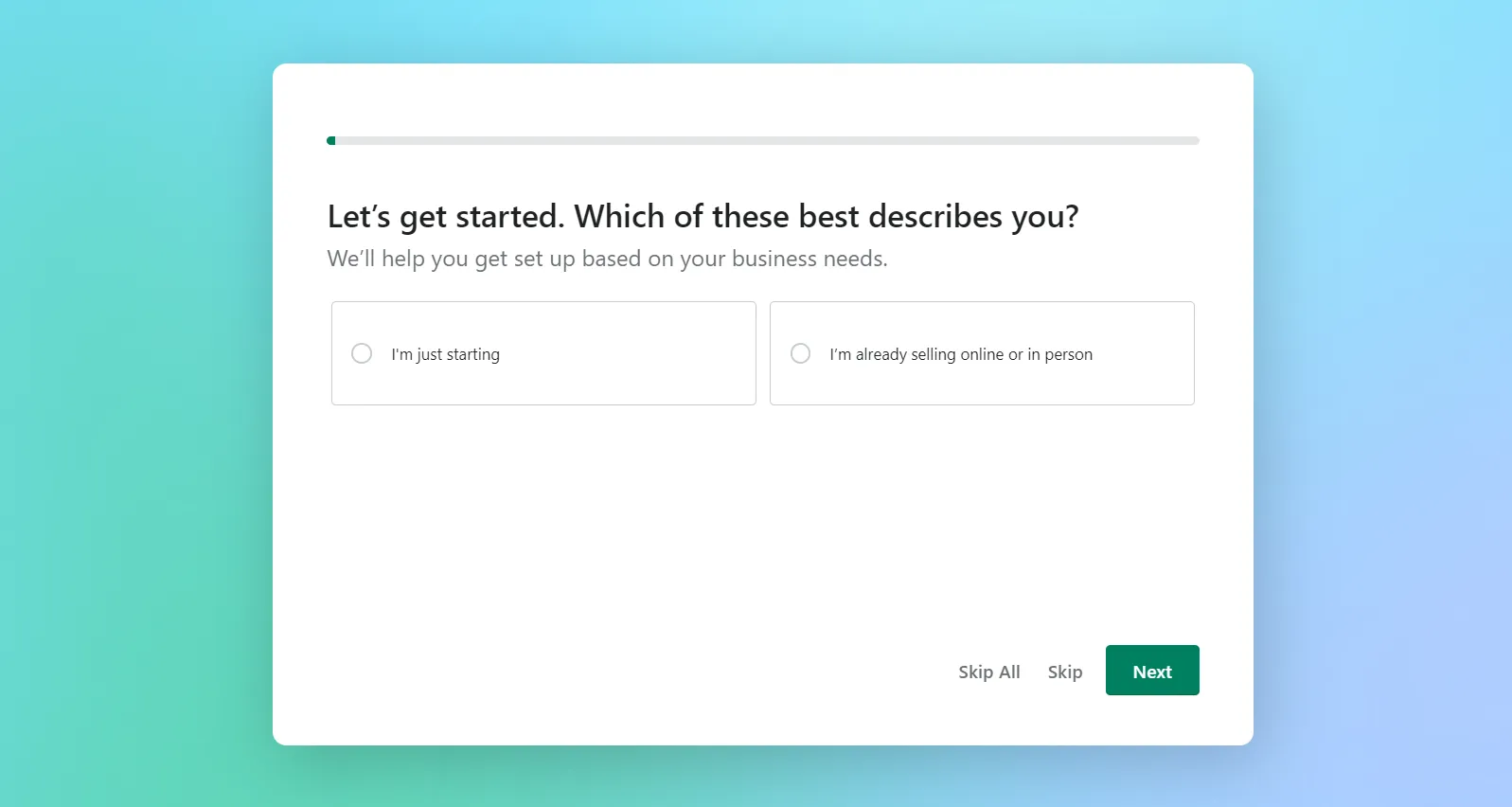
There you go – the Shopify Dashboard, where all of your store’s details will be built and furnished.

In case you don’t know where to start, our Shopify setup tutorial video might be helpful.
How to Migrate from Lightspeed to Shopify in 3 Steps
Now that you have settled down with your new store, let’s start the Lightspeed to Shopify migration process. Through 10+ years working in the eCommerce industry, LitExtension has maintained our position as the #1 Shopping Cart Migration Expert with 99% customer satisfaction on Trustpilot.
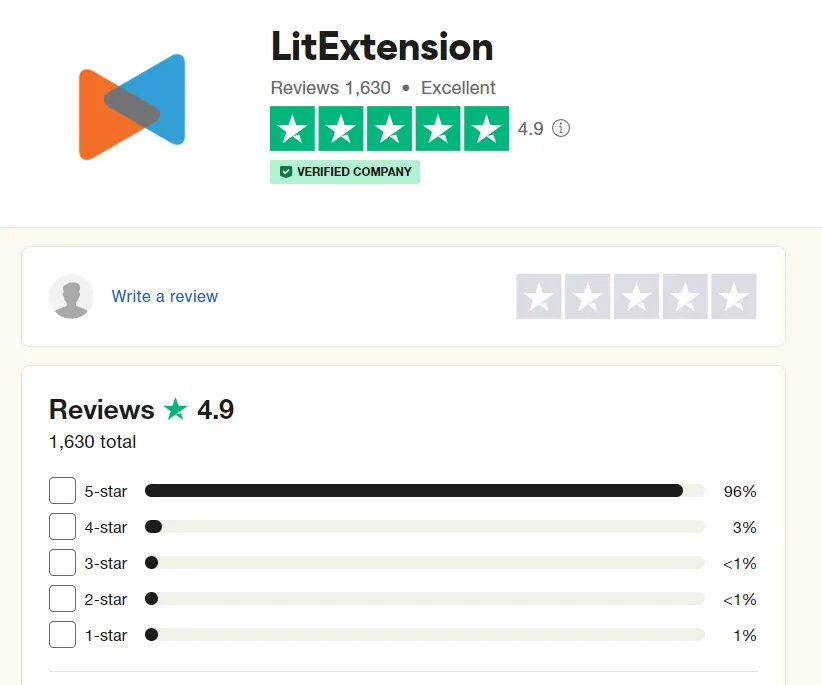
There’s no need for in-depth technical expertise. Your Lightspeed data will be automatically, accurately, and securely transferred to Shopify with the help of LitExtension – #1 Shopping Cart Migration Expert.
1. Set up Source Cart and Target Cart
To begin with, create a new account on our LitExtension website (in case you haven’t had one). We also provided the two other sign-in options via Facebook and Google for your convenience. Pick out the most suitable method of your choice.
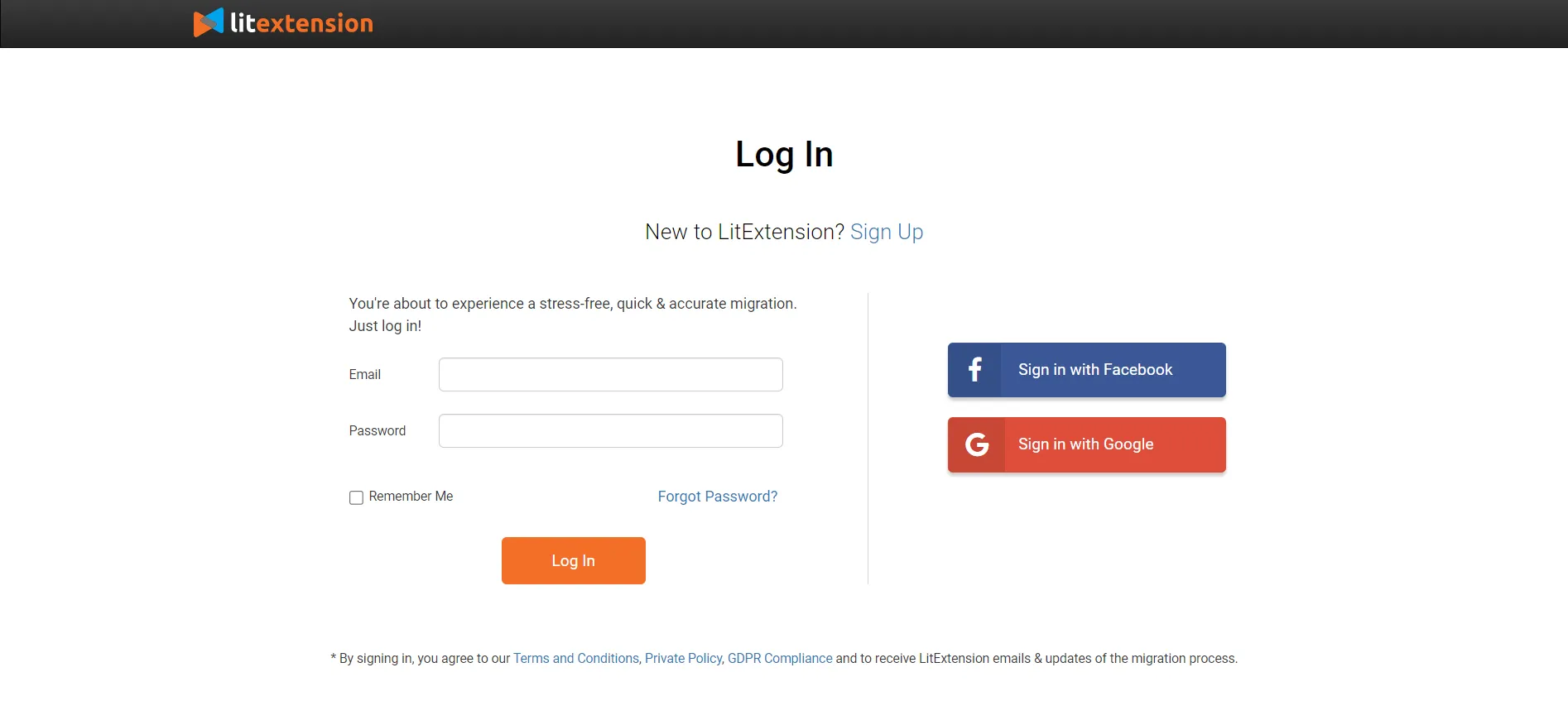
Once you have successfully logged in to LitExtension, navigate to the “Create Migration” tab at the top of the screen and start configuring the Source Cart and Target Cart. With the Source Cart section, select “Lightspeed” from the dropdown menu:

Fill in the Url, Lightspeed API key, and password to continue. Below are the steps to create and modify your API key on the Lightspeed eCommerce version.
- First, go to Store Settings > Settings > Developers menu.
- Second, hit “New API Key”.
- Choose a name for your API key. This could be the developer or integration name.
- Click “Save”.
- Turn on the “API Key” toggle under the Settings section.
- Tick all the checkboxes for your API permissions and select “Save”.
- Your API key can now be found in the “Details”.
If you are using the Lightspeed Retail POS service, getting your API key is much more complicated. Therefore, we recommend purchasing our All-in-One Migration Package for more support and to avoid possible mistakes.
Similarly, select “Shopify” for the Target Cart setup. LitExtension will also require you to enter the URL and Shopify API Password. If you install LitExtension from the Shopify App Store, the system automatically identifies your API key.

When you’re ready, hit “Next: Configure your Migration” to continue.
2. Select entities to migrate
The data you want to move from Lightspeed to Shopify is now available for selective migration. LitExtension provides a wide range of fields for your migration from products, and customers to orders, etc. Tick on the checkbox for data types you wish to relocate or choose “Select all” to fulfill your requirements.

One of the perks when using LitExtension is the ability to customize the Lightspeed Shopify migration process to your preference. That is to say; you will be able to configure further settings in the “Additional Options” section. Here are some of the most popular choices for your reference:
- Clear current data on Target Store before Migration
Select this option to permanently delete all Target Store-related information from your system. Moving your store from Lightspeed to Shopify will be a breeze thanks to this feature.
- Preserve Order IDs on Target Store
If you choose his option, your Source Store IDs will remain the same on the Target Store even after the migration is finished. Thus, you can guarantee smooth inventory management despite the platform transition.
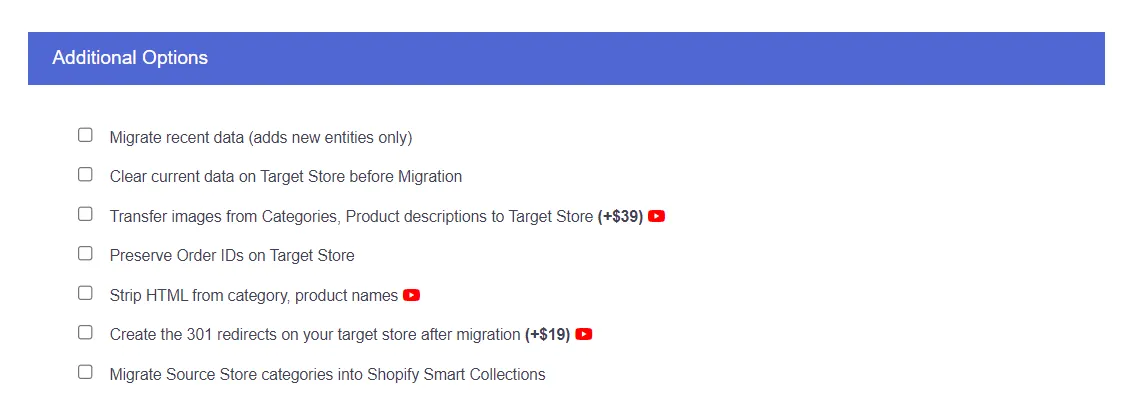
Another thing to note is to map order status and language between Lightspeed and Shopify before the full migration. Because of the structure differences, doing this will help you save time getting used to the new platform.
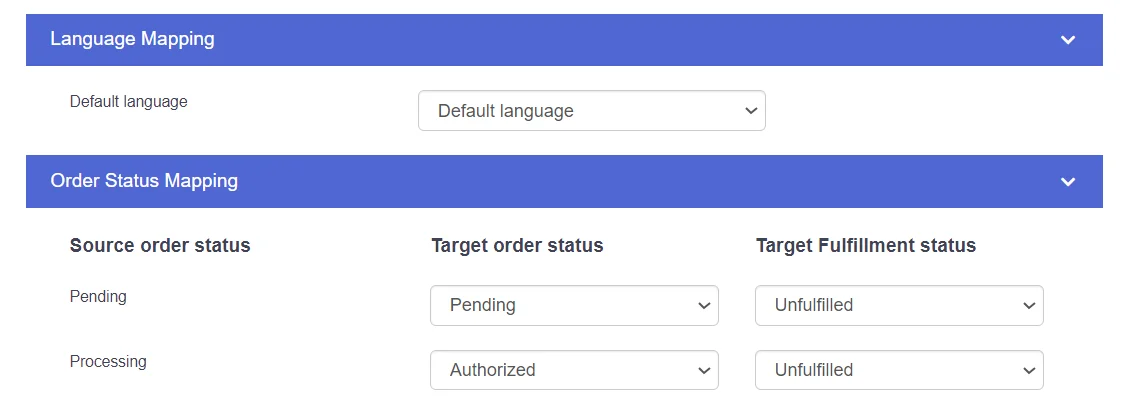
3. Run Full Migration
Here comes the last step! If you want to view how our migration service works before going with the real deal, try our FREE DEMO. Thanks to it, you may verify the outcome on your Target Cart to assess the efficiency, safety, and precision of our service.
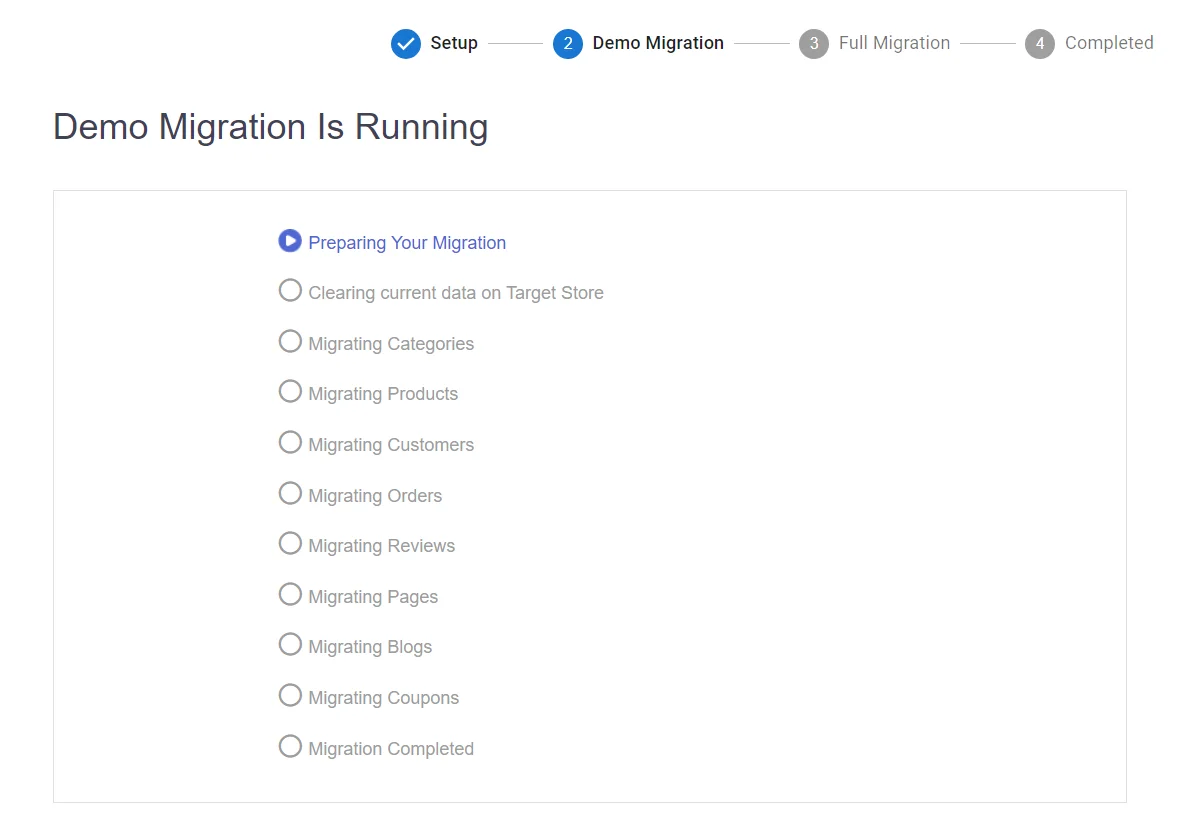
Otherwise, tick the “Skip Demo Migration” checkbox and run the full migration by clicking on “Next: Start Full Migration”.
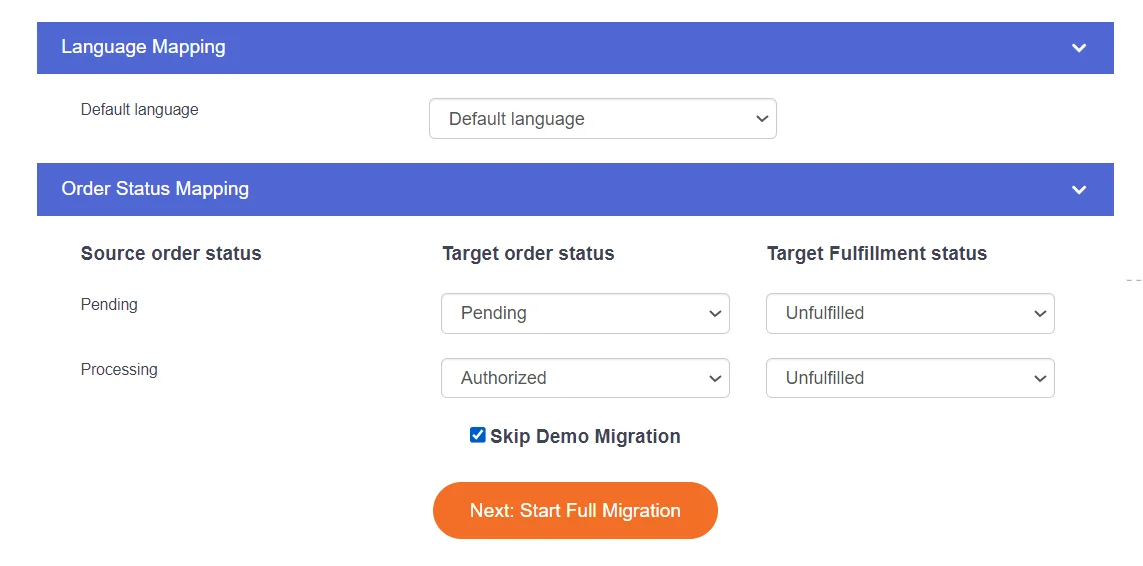
Keep in mind that once the migration has begun, it will proceed without any interruptions on the server. Consequently, you may shut down your computer while data is being transferred. When everything has fallen into place, a notification message will be sent to your email address:
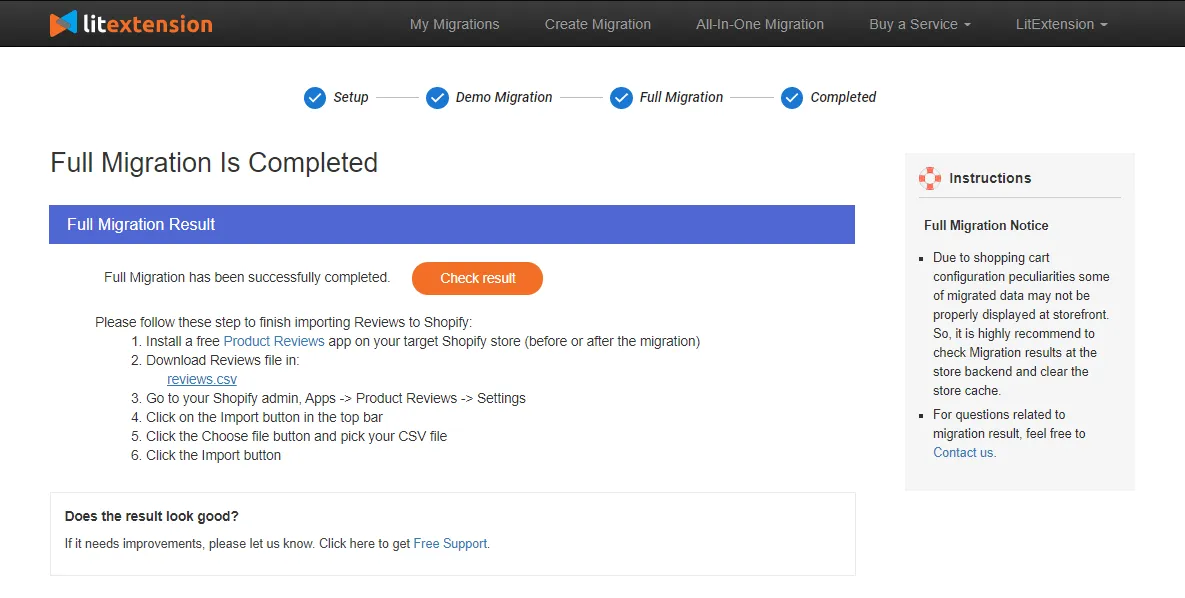
Hooray! Your data has now been migrated to a new home called “Shopify”. We’re almost there. Just a few more steps, and you can start generating profits.
Save Time Migrating Your Store to Shopify
Trusted specialists streamline migrations that actualize ambitions.
Lightspeed to Shopify Migration – Go-live Checklist
When you use our LitExtension service, your current website will continue to function normally during the transfer process from Lightspeed to Shopify. To clarify, the database will be kept current with any new orders and customers that come in.
Knowing your worries about the website not being updated, LitExtension has provided these handy post-migration services:
- Recent data migration: guarantees that any new orders or clients created by your source store are automatically received by your new store throughout the migrating process.
- Smart update: enables you to update data that has been modified and migrate new data that has appeared in your Source Store during or after the migration.
- Re-migration: permits you to redo the migration process from Lightspeed to Shopify.
Within the first three months from your full migration, you are able to use these services at no cost if the amount of data is less than 10% of the total from the initial migration. For instance, here’s how our Recent data migration service works:
After that, continue to double-check your migration result using our checklist listed below. For detailed information on each step, this tutorial might be helpful.
- Check the final result
- Change DNS and switch domain
- Decide shipping methods
- Select the payments
- Place test orders in advance
That’s everything! What are you waiting for? This is your time to kick off Shopify!
Lightspeed vs Shopify – An Overview
1. What is Lightspeed?
Lightspeed is a one-stop commerce platform that streamlines and modernizes offline and online operations by supporting various payment methods, geographical development, and other business functions.
Currently, they offer 4 services, including:
- Lightspeed Retail
- Restaurant
- Golf
- Lightspeed eCommerce
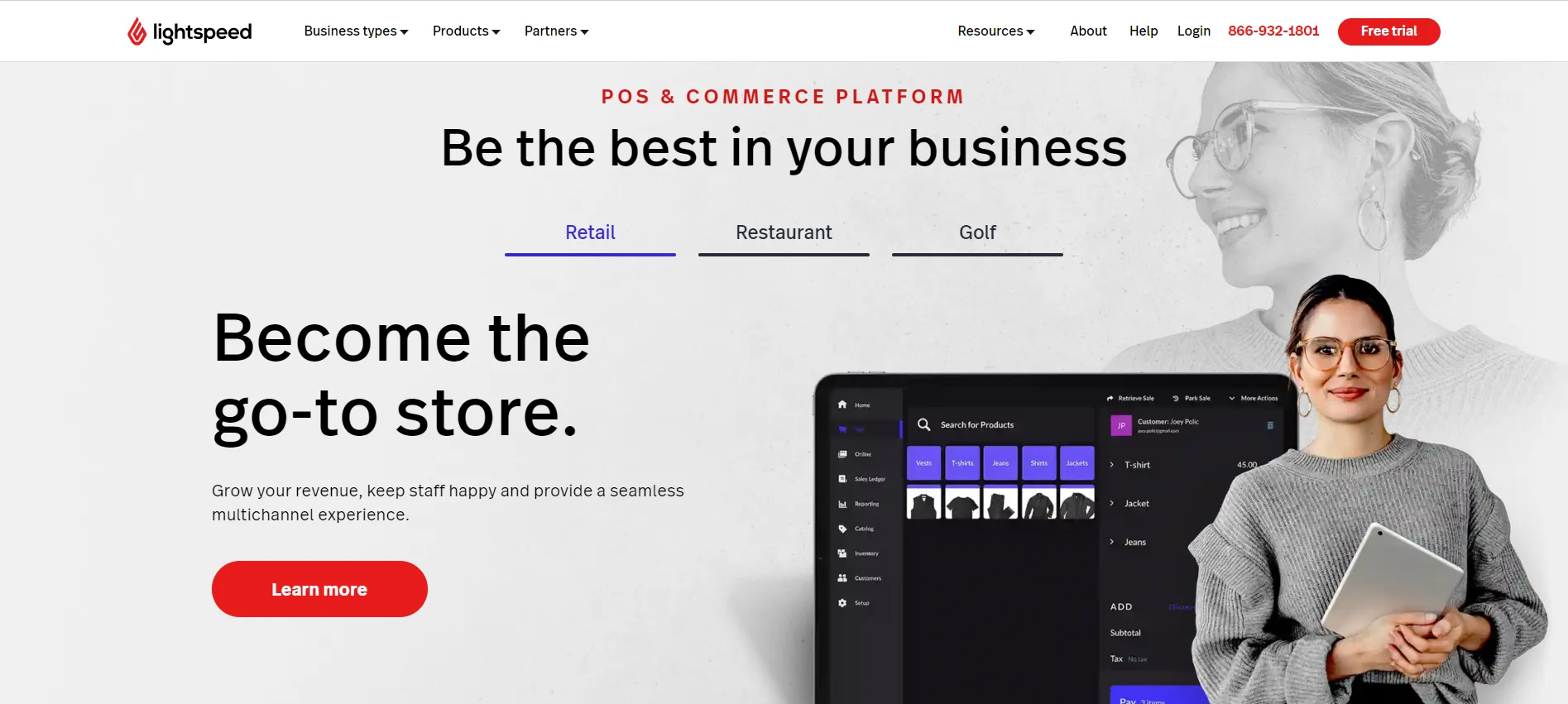
With more than 15 years of experience, Lightspeed is well-known for its outstanding features: inventory management, analytics, payment processing, and purchase order administration. Hence, retailers may effectively manage their brick-and-mortar businesses and generate profits quickly.
2. What is Shopify?
Shopify is one of the giants when it comes to eCommerce platforms. Originally developed in 2006 to facilitate the sale of snowboarding gear online, it has now expanded to become an “all-in-one” ecommerce platform serving online retailers of all sizes and scopes across sectors.
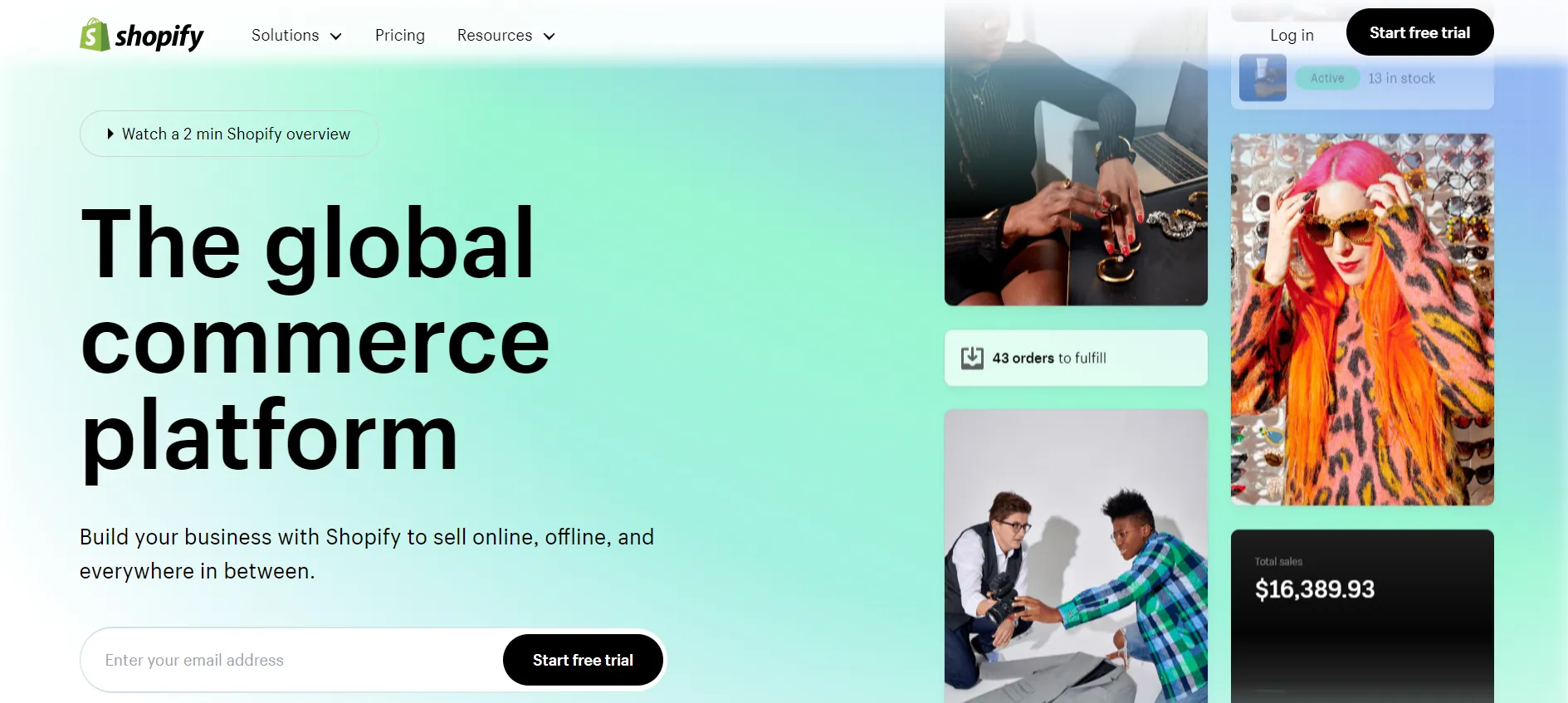
Thanks to its numerous and powerful eCommerce features along with an easy learning curve, Shopify has been chosen by over 4.12 million businesses to build their website. You may create your own website from scratch or use their mobile POS system to easily handle both online and offline inventory.
Our collection of blogs about Shopify might interest you:
- Shopify review: Is Shopify the crown jewel of the eCommerce world?
- How to start a Shopify store: Ultimate guide for beginners
- Login to Shopify: A guide to kickstart your business
3. A comparison of Shopify vs Lightspeed
To help you better understand the differences between Lightspeed vs Shopify, we have compiled a list of pros and cons. This way, you can make the best decisions while choosing a platform.
[wptb id=60296]
Benefits When Moving from Lightspeed to Shopify
Both Lightspeed and Shopify have their own advantages and disadvantages. However, when we take a closer look, it is likely that Shopify has won the competition for multiple reasons. And we will explain one by one why migrating from Lightspeed to Shopify is an ideal option.
1. Cost-effective
1.1. eCommerce version
Firstly, let’s take a look at their monthly pricing plans. At first glance, Lightspeed charges lower fees for their eCommerce version. Yet, the features are significantly limited in comparison to Shopify, from the number of products to sales channel integrations, etc.
- Venture: $19/month ($14.08 annually).
- Business: $39/month ($29.08 annually).
- Unlimited: $99/month ($82.50 annually).
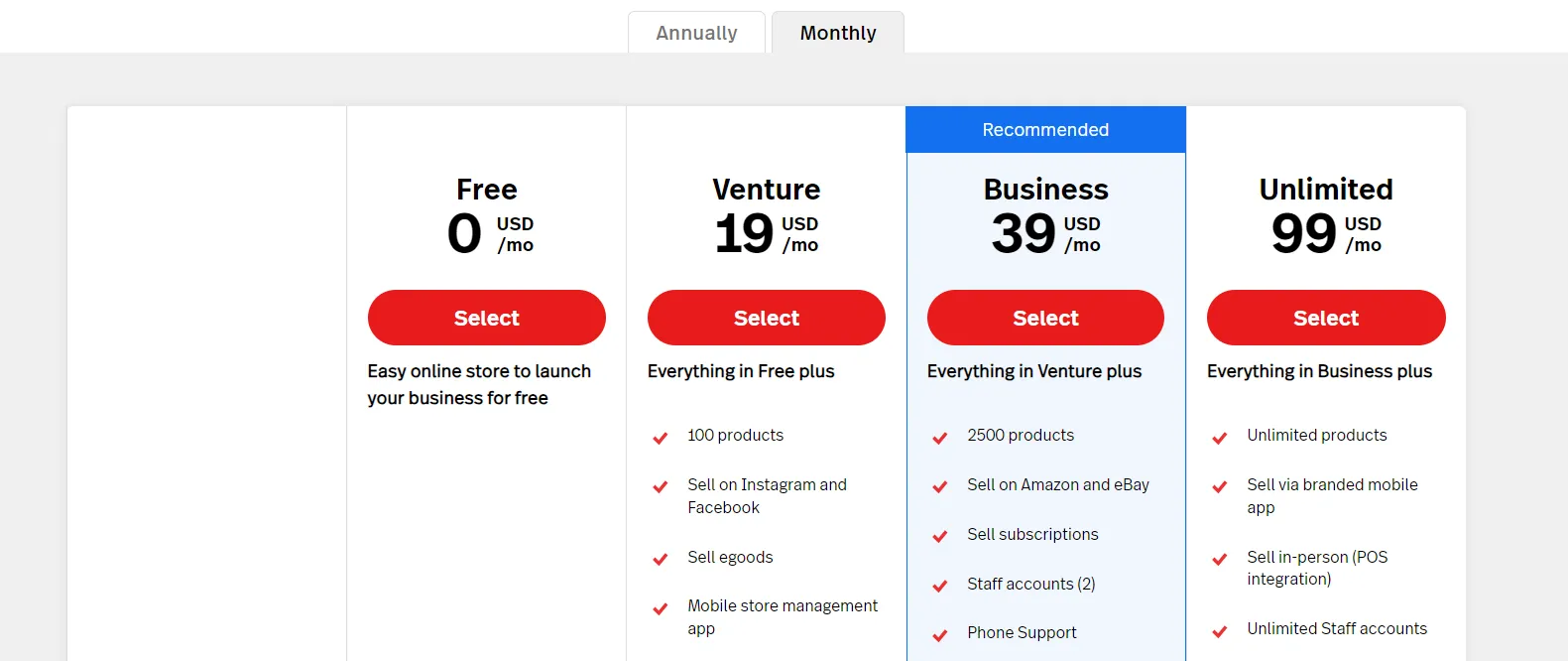
Shopify provides its users with 5 pricing plans, with the lowest one called “Starter”, which only charges you $5/month. In addition, the platform comes with three tiers for you to choose from, which all contain a fully functional online store:
- Basic: $39/month (or $29/month if paid yearly).
- Shopify: $105/month (or $79/month if paying annually).
- Advanced: $399/month (or $299/month if paying annually).
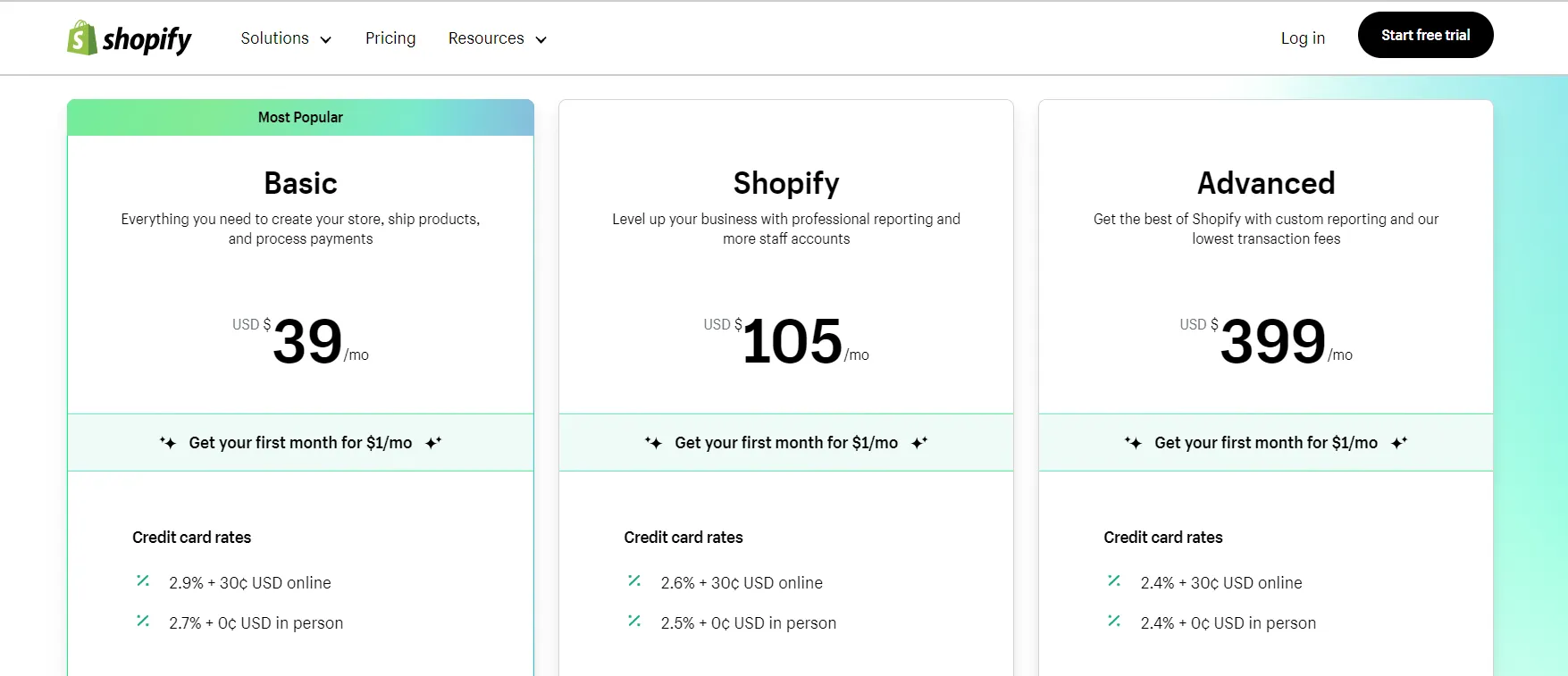
Shopify and Lightspeed both have tiered pricing, so the features you get depend on the package you choose. Apparently, Shopify comes out on top since it has a more cost-effective initial rate. Notwithstanding, the platform also packs you with the most robust eCommerce features, allowing you to upgrade the plan as your company expands.
Gain insightful information with our article on Shopify pricing: The full costs of owning a Shopify website.
1.2. POS System
Besides eCommerce, the most common service provided by Lightspeed is its POS system. There are three retail POS subscription levels:
- Lean: $139/month ($119 annually).
- Standard: $199/month ($169 annually).
- Advanced: $319/month ($249 annually).
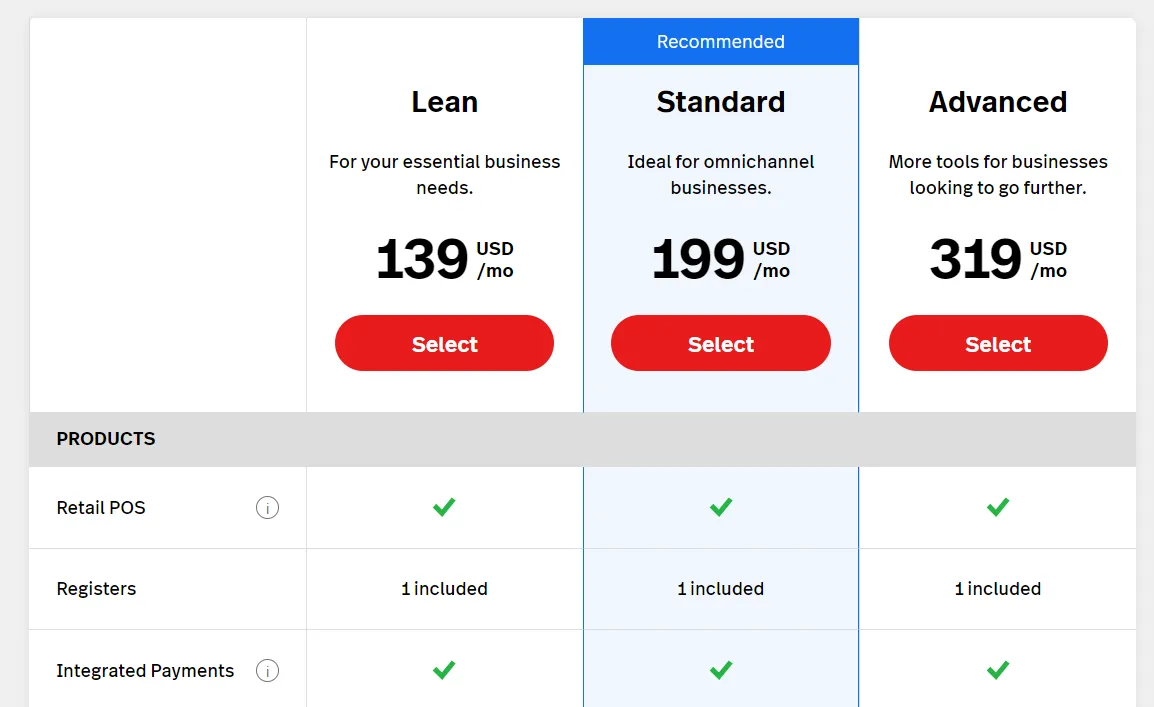
On the other hand, Shopify POS is completely free of charge and packed within all Shopify pricing plans. You may upgrade to POS Pro at any of your stores after signing up for a Shopify subscription. And this only charges you $89/month ($79/month if billed annually).
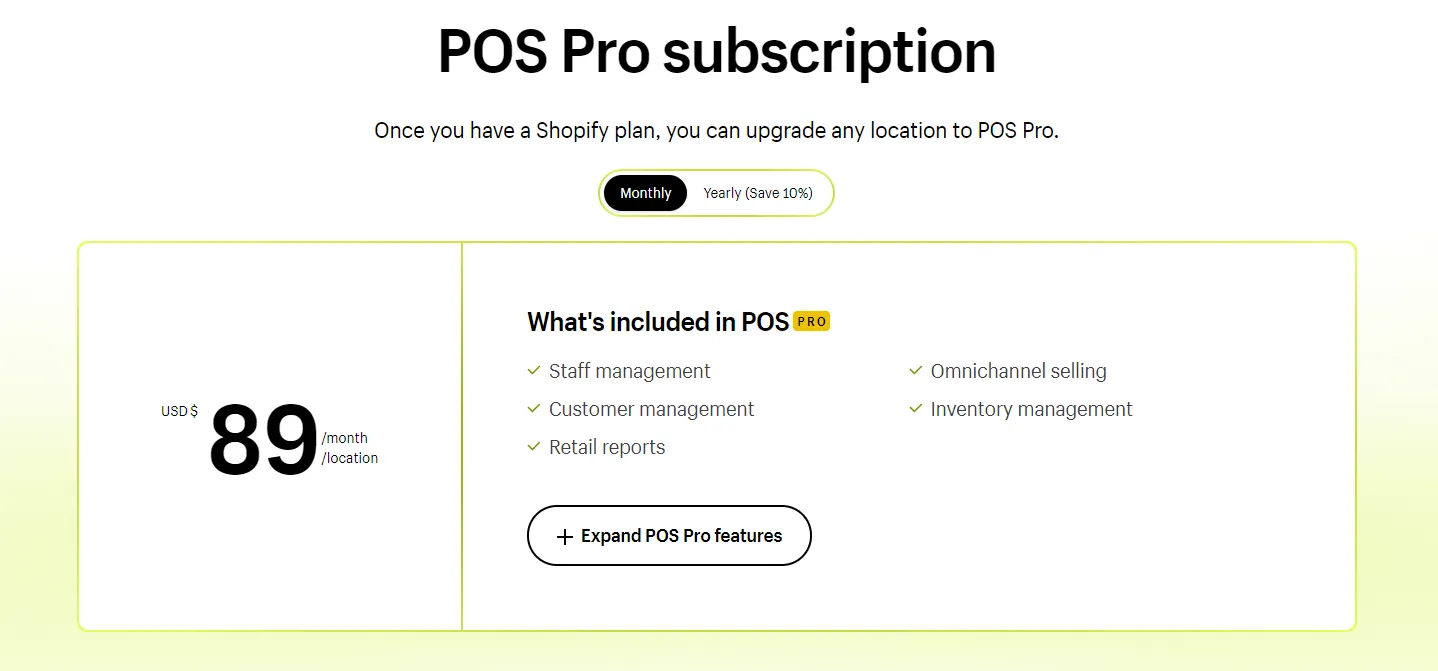
2. Enhanced inventory tracking
Shopify inventory monitoring capabilities and applications may save you money on shipping & handling. Orders will be processed rapidly without sacrificing efficiency or precision. Consequently, this will ultimately boost inventory efficiency.
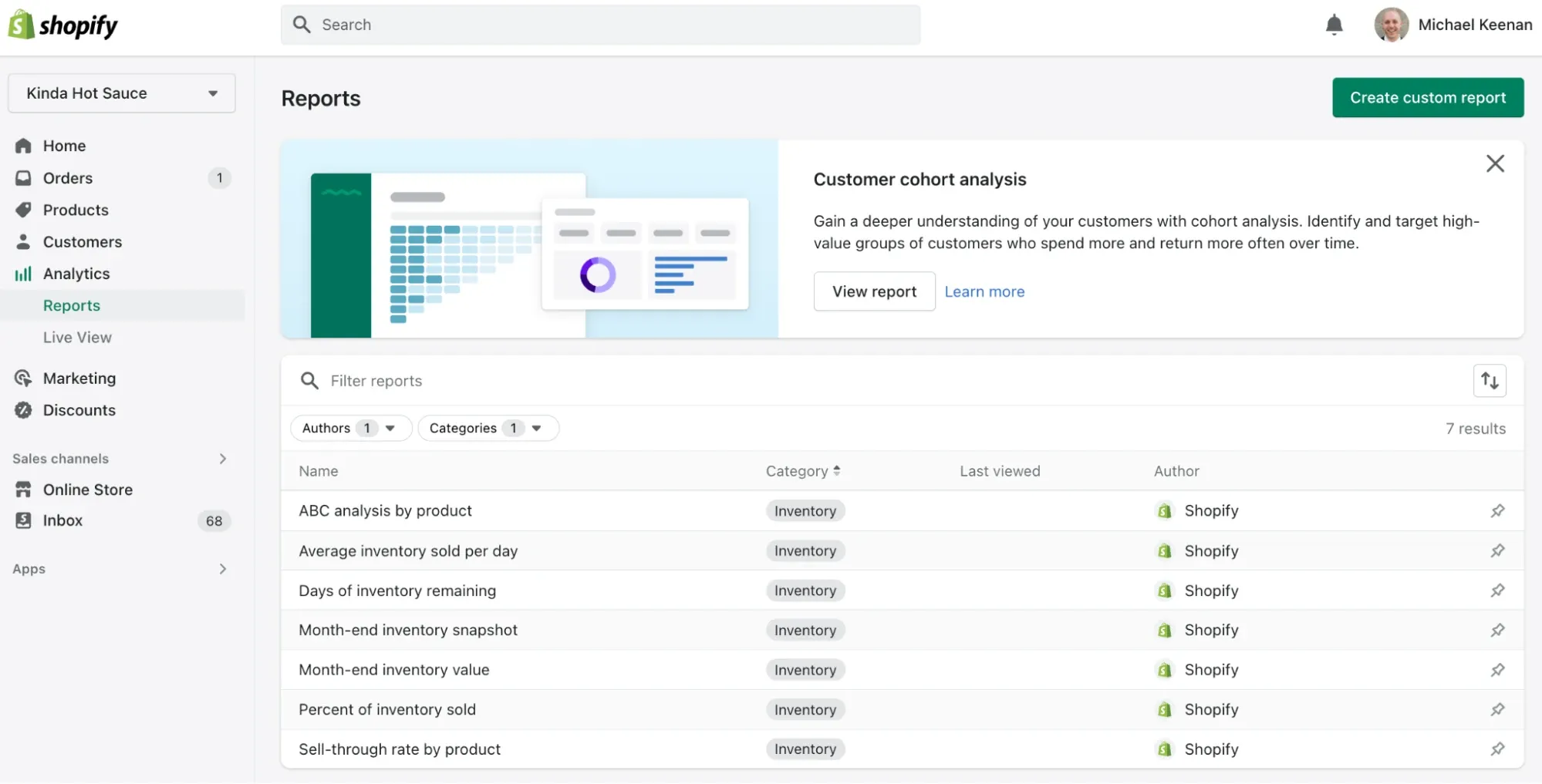
Plus, there are inventory reporting capabilities, so you can get the information you need to make smart choices about your inventory (including how to allocate it). In layman’s terms, this means you may use a data-driven strategy for efficient storage, prompt distribution, and minimal shipping costs.
3. Powerful customization tools
As expected, Lightspeed puts more emphasis on its POS systems than on its online store building. Their Lightspeed eCommerce collection consists of 50 different themes, some of which are available at no cost. However, the premium templates will cost you around $26.50 every month.
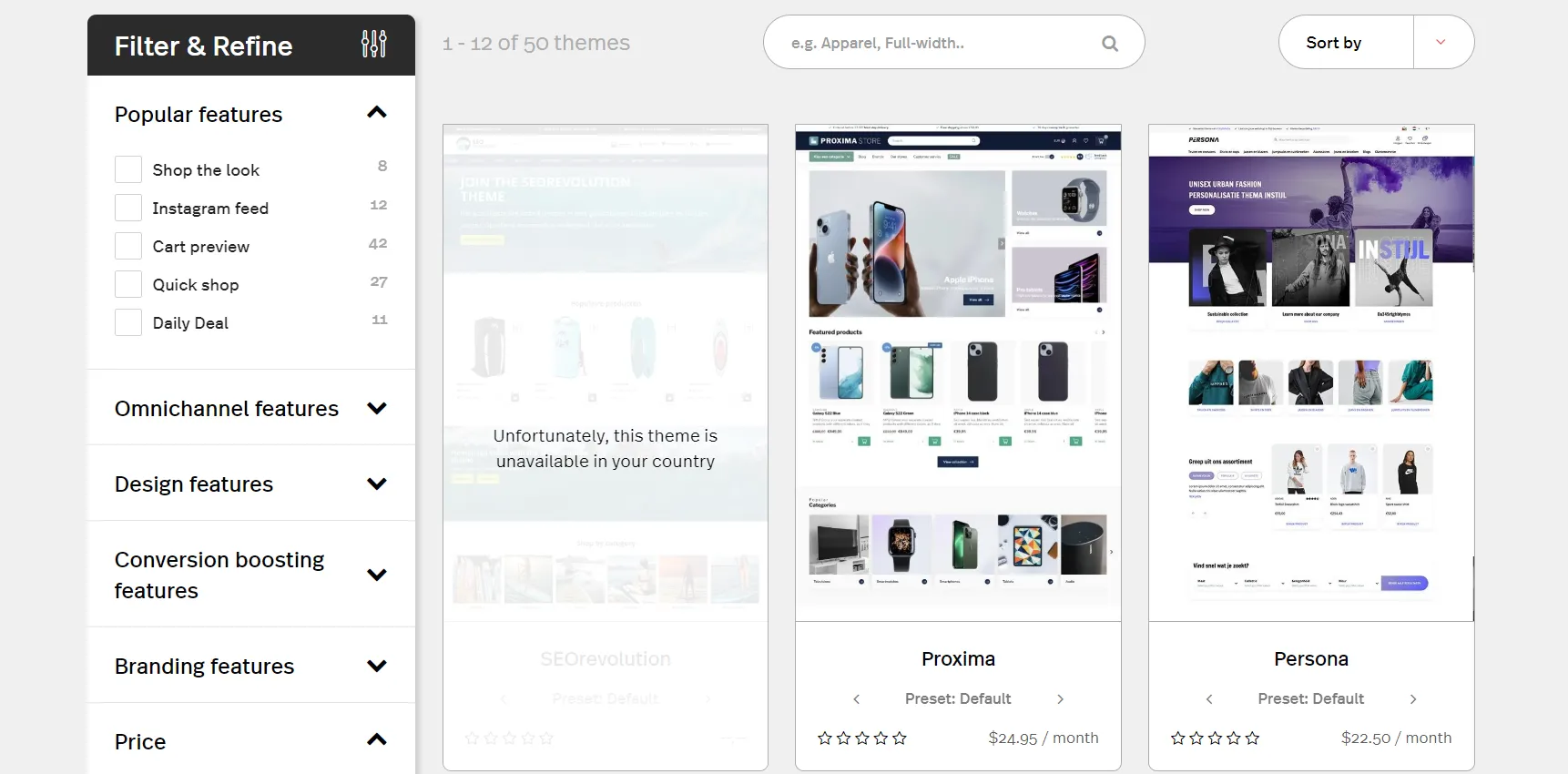
Another downside is that your website’s functionality depends on the theme you choose, and you cannot modify a template for more advanced functions.
Meanwhile, Shopify comes with 130+ themes (both free and paid ones) that suit all types of industries. Instead of paying monthly, their premium options are all one-time payments, which saves up tons of money compared to Lightspeed.
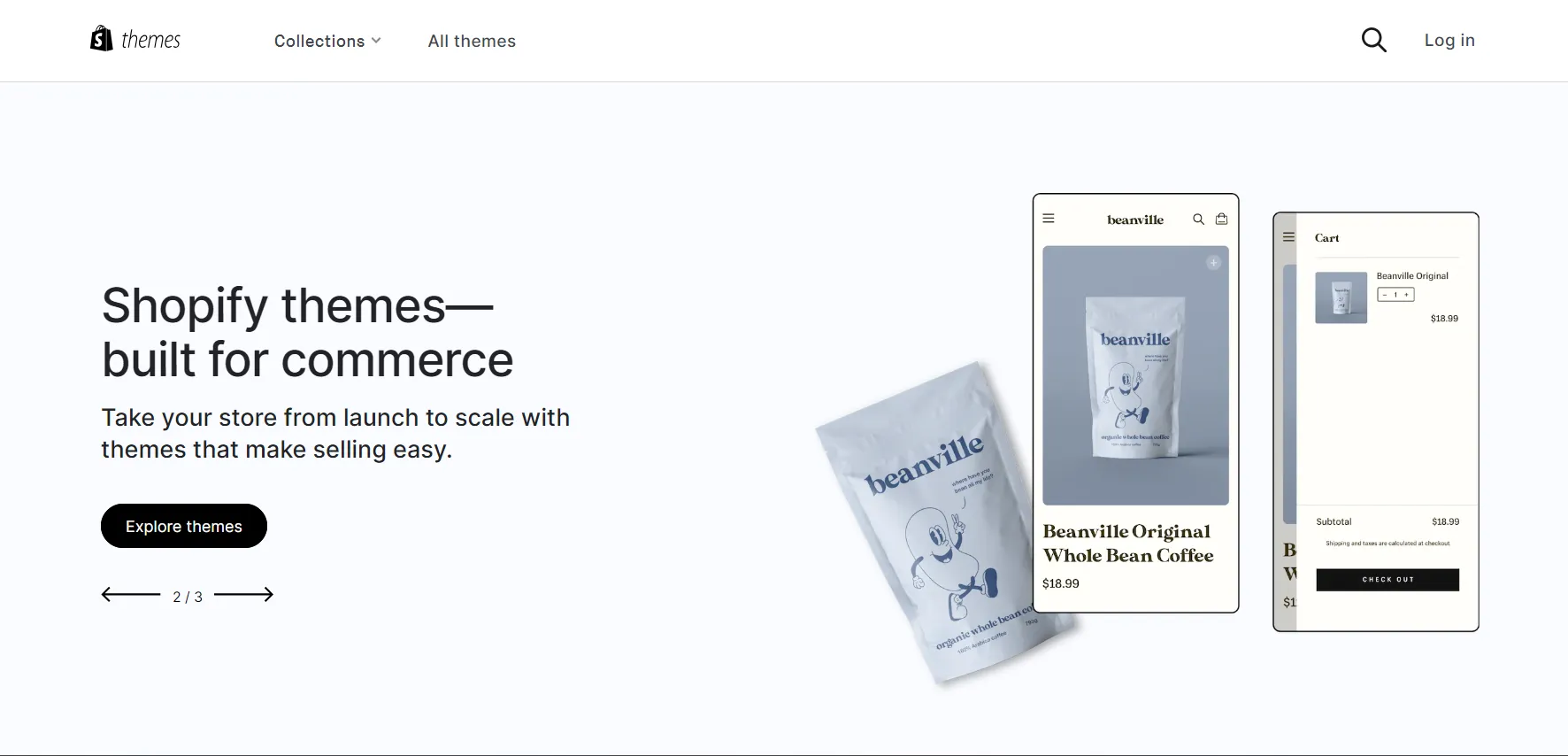
Not to mention, Shopify’s customization tools allow merchants to perfect their website to every corner. Furthermore, you can even gain access to their coding effortlessly for more control over the design.
Explore more exquisite designs from Shopify with our articles:
- Best Shopify themes: Have you got one?
- 15+ best Shopify themes for conversion: The ultimate picks
- Best Shopify themes for SEO: Top 15 for you to try
4. Mobile-friendly interface
Compared to Lightspeed, Shopify POS has a superior mobile application version. For starters, their higher average star ratings indicate that their app is of greater quality.
Second, they support both the Android and iOS platforms. Although Lightspeed does offer a mobile application, you still have to use the web-based version when accessing their POS system via Ipad.
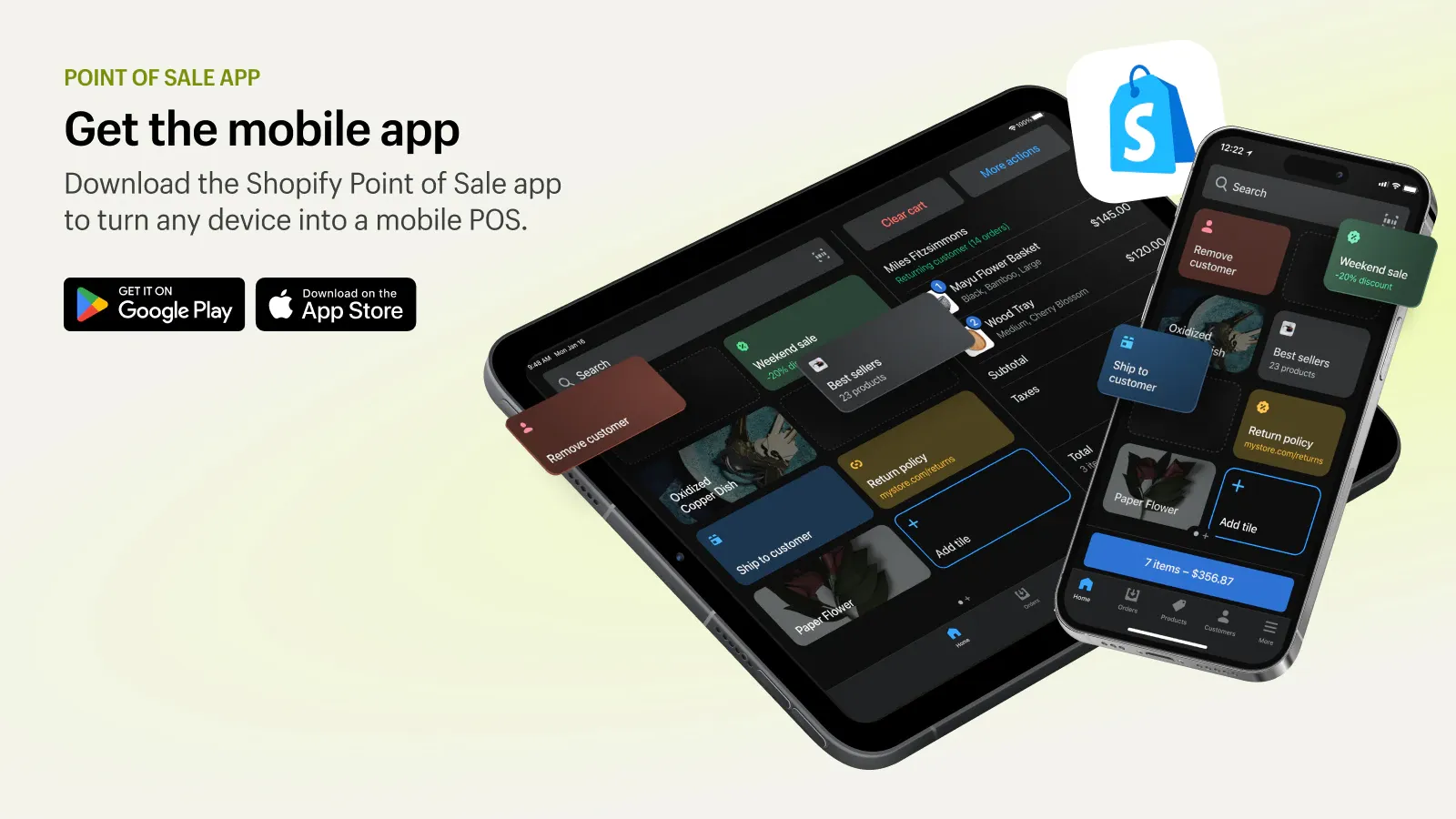
With the POS Shopify mobile software, you can process payments, gather customer information, scan barcodes with your phone’s camera, and use Apple Pay with the press of your finger.
If a consumer creates a shopping cart but does not complete their purchase, you may store their cart and follow up with them through email. This is not available on Lightspeed.
5. Various payment gateways
With Shopify, you can accept payments from customers via 100+ different methods, including the most favorable ones like PayPal, Stripe, Apple Pay, Amazon Pay, and also the in-house Shopify Payments.

The per-transaction fee depends on the Shopify plan you subscribe to. The more expensive plan you go for, Shopify will charge a lower rate, which is quite cost-saving as your business expands in the future.
Lightspeed provides a straightforward option: either utilize Lightspeed Payments, their in-house solution or pay an extra $50 per month to use one of three supported payment connectors. Apart from paying the extra fee, you will also have to include the gateway fee, which might add up a lot of money just for the payment.
6. Extensive collection of apps
Shopify stands out thanks to its enormous number of robust apps. More than 2,000 alternatives from the Shopify App Store to help you tailor your store to specific needs. Most of them provide user ratings, so you can see how well they’ll match your demands before purchasing.

More apps are waiting for you:
- Best Shopify apps: 15+ for any type of website
- Free Shopify apps: 25+ to boost your sales
- Best dropshipping apps for Shopify: 10 ones you can miss
On the contrary, Lightspeed only provides access to just about 70 extensions, which is a pretty huge gap compared to Shopify. Thus, it might be difficult for the platform to adapt to your needs as your business grows.
Final Verdict
In short, we found that moving from Lightspeed to Shopify is a more recommended solution. This is because Shopify provides all the tools necessary to create a fully functional online business. In addition, it offers a wide variety of capabilities for brick-and-mortar retailers, and its hardware is reliable.
Lightspeed, on the other hand, is a strong rival to Shopify with reliable POS service but falls short on eCommerce features.
What to Consider Before Migrating from Lightspeed to Shopify?
There are a number of factors to think about or undertake while planning your switch from Lightspeed to Shopify.
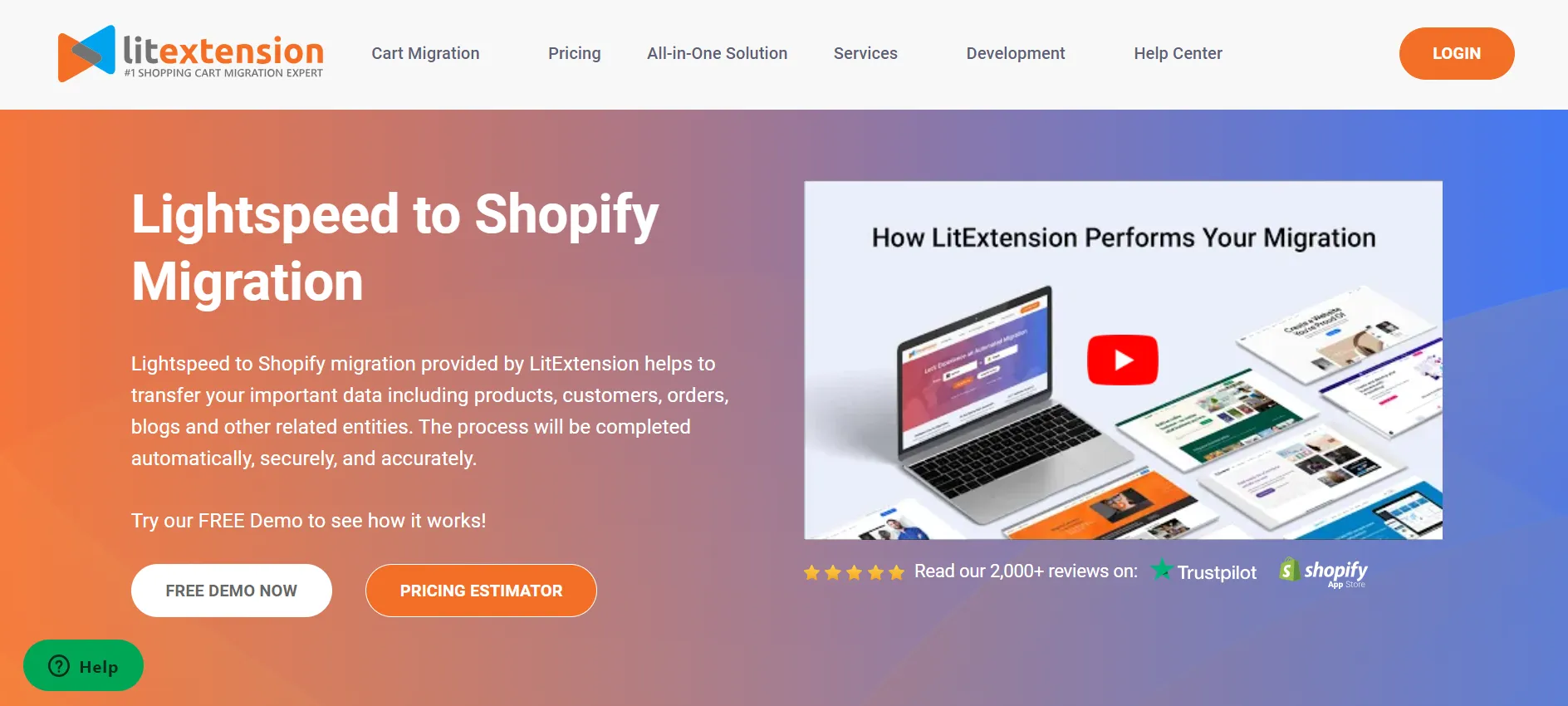
- Customer Experience Enhancement
Ensure that all necessary resources, including photos, theme styles, and style sheets, are easily accessible. If you neglect this phase, store management may become more complex, and your customers may have a worse overall experience.
- Customer Passwords
Password encryption methods and data structures may differ across platforms. During the transition from Lightspeed to Shopify, the clients’ old passwords will no longer work. This might cause problems for customers and reduce their enjoyment of the product.
For that reason, we recommend you take a look at our Customer Password Migration service for future reference.
- Community and Networking
Users may reach out to Lightspeed at any time for general inquiries, but they need to make appointments in advance for tech support. Also, if you need assistance, you may reach them via their AskLightSpeed Twitter account.
Shopify has 24/7 technical and customer assistance. Shopify’s customer and technical support features include a help center, webinars, and video tutorials, as well as a dedicated support staff.
How Much Does Lightspeed to Shopify Migration Cost?
The total cost of your LightSpeed to Shopify migration varies significantly depending on the method you go for. Doing it yourself might be a cost-effective option. Due to the high level of technical skill required and the potential difficulties during data movement, we do not recommend opting for this approach.
You may also get assistance by employing a developer or web agency. Their hourly rates often range from $50 to $80. However, it may be challenging to locate a web design firm or freelancer with in-depth knowledge of a platform’s data structure. Or else you may have to wait longer and pay more for the maintenance costs.
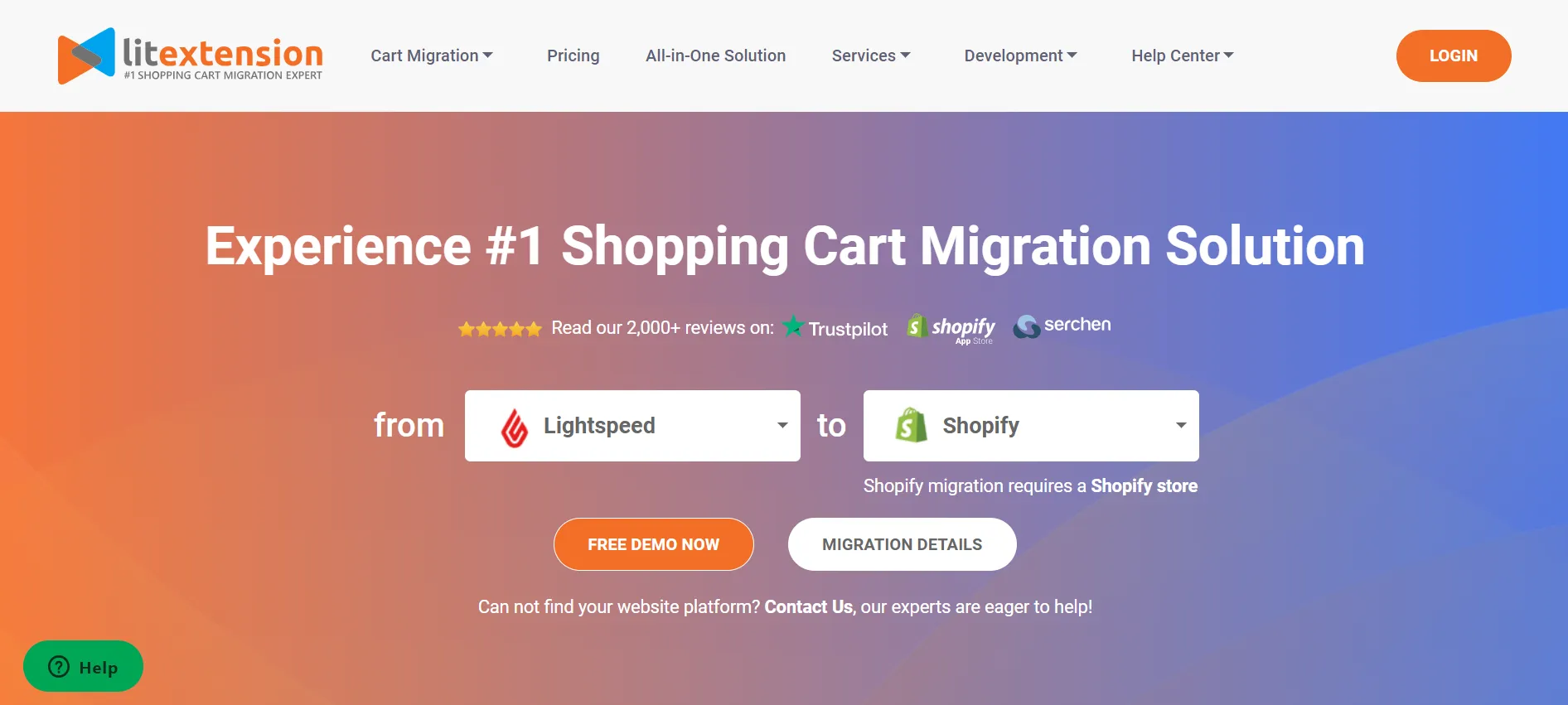
With LitExtension, you can save up to 88% of the total cost spent for the migration process. There are 2 pricing ranges that LitExtension offers:
- Basic Migration Package: starts from $79.
- All-in-One Migration Package: starts from $139.
Our service is developed based on strong background knowledge of both platforms’ structures. As a result, you might be relieved knowing that your store is in good hands. Contact us for more consultations now!
Besides Lightspeed, LitExtension also provides migration service to help merchants migrate from other eCommerce platforms to Shopify:
What Entities Can Be Migrated from Lightspeed to Shopify
Here’s the list of full entities that can be migrated from Lightspeed to Shopify:
[wptb id=60291]
Moving from Lightspeed to Shopify – Recap
In the preceding section, we laid out the 6-step process by which you may switch from Lightspeed to Shopify:
- Run Lightspeed backups – to avoid data loss or corruption during the migration process.
- Create a Shopify store – the new destination of your data.
- Set up Source Cart and Target Cart – provide both Lightspeed and Shopify API key password.
- Select migration entities – pick out the most suitable entities for your need.
- Run the full migration – to see how our service works with the free demo beforehand.
- Follow the post-migration checklist – kick-start your business with Shopify!
Migrate Lightspeed to Shopify – FAQs
[sp_easyaccordion id=”60290″]
Key Takeaways
In conclusion, the Lightspeed to Shopify migration was not that complicated as long as you followed the steps closely. Hopefully, after our guide today, you have smoothly moved from Lightspeed to Shopify and drive sales.
For more awesome tips and tricks, don’t hesitate to check out our LitExtension Blog or join the Facebook Community Group now!

